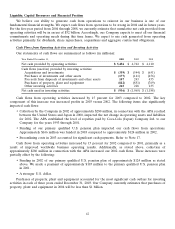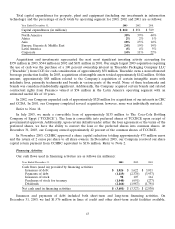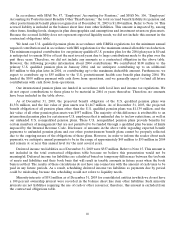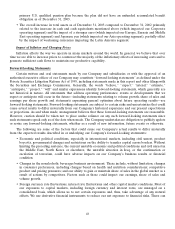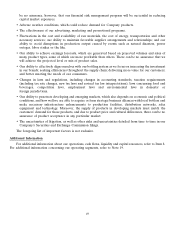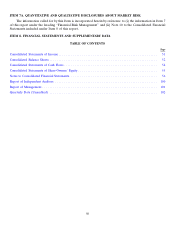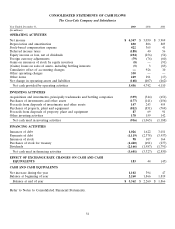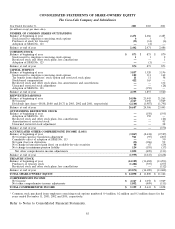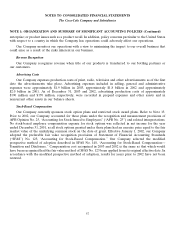Coca Cola 2003 Annual Report Download - page 51
Download and view the complete annual report
Please find page 51 of the 2003 Coca Cola annual report below. You can navigate through the pages in the report by either clicking on the pages listed below, or by using the keyword search tool below to find specific information within the annual report.
primary U.S. qualified pension plan because the plan did not have an unfunded accumulated benefit
obligation as of December 31, 2003.
• The overall increase in total assets as of December 31, 2003 compared to December 31, 2002 primarily
related to the increase in cash and cash equivalents mentioned above (which impacted our Corporate
operating segment) and the impact of a stronger euro (which impacted our Europe, Eurasia and Middle
East operating segment) and Japanese yen (which impacted our Asia operating segment), partially offset
by the impact of weakening currencies impacting the Latin America segment.
Impact of Inflation and Changing Prices
Inflation affects the way we operate in many markets around the world. In general, we believe that over
time we are able to increase prices to counteract the majority of the inflationary effects of increasing costs and to
generate sufficient cash flows to maintain our productive capability.
Forward-Looking Statements
Certain written and oral statements made by our Company and subsidiaries or with the approval of an
authorized executive officer of our Company may constitute ‘‘forward-looking statements’’ as defined under the
Private Securities Litigation Reform Act of 1995, including statements made in this report and other filings with
the Securities and Exchange Commission. Generally, the words ‘‘believe,’’ ‘‘expect,’’ ‘‘intend,’’ ‘‘estimate,’’
‘‘anticipate,’’ ‘‘project,’’ ‘‘will’’ and similar expressions identify forward-looking statements, which generally are
not historical in nature. All statements that address operating performance, events or developments that we
expect or anticipate will occur in the future—including statements relating to volume growth, share of sales and
earnings per share growth and statements expressing general optimism about future operating results—are
forward-looking statements. Forward-looking statements are subject to certain risks and uncertainties that could
cause actual results to differ materially from our Company’s historical experience and our present expectations
or projections. As and when made, management believes that these forward-looking statements are reasonable.
However, caution should be taken not to place undue reliance on any such forward-looking statements since
such statements speak only as of the date when made. The Company undertakes no obligation to publicly update
or revise any forward-looking statements, whether as a result of new information, future events or otherwise.
The following are some of the factors that could cause our Company’s actual results to differ materially
from the expected results described in or underlying our Company’s forward-looking statements:
• Economic and political conditions, especially in international markets, including civil unrest, product
boycotts, governmental changes and restrictions on the ability to transfer capital across borders. Without
limiting the preceding sentence, the current unstable economic and political conditions and civil unrest in
the Middle East, North Korea or elsewhere, the unstable situation in Iraq, or the continuation or
escalation of terrorism, could have adverse impacts on our Company’s business results or financial
condition.
• Changes in the nonalcoholic beverages business environment. These include, without limitation, changes
in consumer preferences, including changes based on health and nutrition considerations; competitive
product and pricing pressures; and our ability to gain or maintain share of sales in the global market as a
result of actions by competitors. Factors such as these could impact our earnings, share of sales and
volume growth.
• Foreign currency rate fluctuations, interest rate fluctuations and other capital market conditions. Most of
our exposures to capital markets, including foreign currency and interest rates, are managed on a
consolidated basis, which allows us to net certain exposures and, thus, take advantage of any natural
offsets. We use derivative financial instruments to reduce our net exposure to financial risks. There can
48






